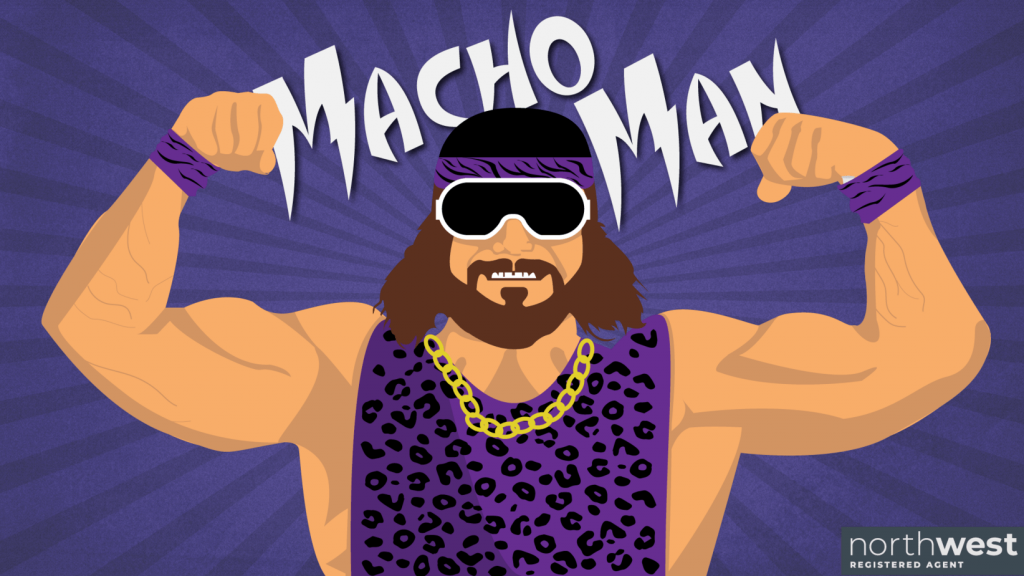What You Can Learn About Branding From Macho Man Randy Savage

It’s easy for small business owners to idolize tycoons like Bill Gates or Steve Jobs and look to the empires that they started in their garages for inspiration. They were mavericks, trailblazers, and all around bad-asses that came from nothing and redefined what Americans think of when they hear the terms “wealth” and “started from the bottom.” It’s an unfortunate reality that icons like them come and go. Our grandparents had Henry Ford. Our grandchildren will have someone else. However, the world will only ever have one “Macho Man” Randy Savage, and, though he’s no longer with us, his legacy carries on.
Why would I mention a Professional Wrestler (a glorified rodeo clown) alongside the visionaries of the new millennium? I do so because a valuable lesson can be learned from Randy Savage, and it’s probably more relevant to a small business owner than you might think. When compared to the other headliners of his era, Savage didn’t have the massive stature or rugged good looks of the competing top-billed stars. He became a champion by establishing his brand, and you can do the same to grow your small business.
Randy’s Four Three Step Program
Branding is a vital part of establishing your budding business and growing product recognition. As a small business owner, your road to higher market share is probably just like Savage’s path to the Intercontinental Championship belt. You’re gonna have to pull out a few more stops, and who knows–maybe a gimmick or two, to set yourself apart from the big guys. That’s done through branding.
The three things you should focus on are industry research, developing a culture, and Advertising/Theme. Randy’s personal plan had a fourth step: steroids. We at Northwest Registered agent don’t recommend that one.
Industry Research
Before Randy was “Macho,” or even really a man, he did his homework. From watching his amateur wrestler father as a child, he picked up on the secret to becoming a world champion; you have to set yourself apart. That’s how you get writers to script you into being a champion, and that’s how you get customers to prefer your product. Take a look at the local businesses that sell the same products or services as you. The goal is to be distinguishable. What does your competitor’s marketing say that gets them in the door? How can you say something different for greater effect? Lets say you offer a product or service that is serious in nature and your competitor’s branding is professional and stoic. If you develop a business identity and culture that is just a bit more tongue-in-cheek, you’ll have near instant brand recognition. You cant know how to set your business apart without researching what you’re setting it apart from.
Developing a Culture
I’d be willing to bet that the word “culture” has never been used in the same sentence as “Macho Man Randy Savage,” but just hear me out. Savage became a fan-favorite and sold out arenas because he spent years building a character that was marketable and appealed to the masses. Whereas most wrestlers of the time projected tough and intimidating personalities, Savage was just plain goofy. It was that kind of contrast compared to his competitors that made him a sensation. Other wrestlers were showcased as playboys, womanizers, and outlaws, but Randy Savage’s brand culture was based on him being the lovable, wholesome, meathead. Randy’s core message was that of fun, sportsmanship, and always being the underdog. Developing a culture for your small business is like curating it’s personality, and the personality of your small business should reflect the wants and needs of your customers. Ask yourself what kind of experiences are your customers seeking, and what can the culture of your small business do to exude that experience.
Advertising/Theme
No one could rock a press conference like the Macho Man. The fluorescent tights, the deep raspy voice, the corny one-liners, the constant flexing that made him look like he was one heart beat from an aneurysm. These weren’t all just isolated gimmicks, they were consistent throughout his career and added up to a character that is still loved today and recognized world wide. To create an iconic brand for your business, delve deeper into the visual elements that culminate into your company’s cohesive theme. Having one logo pasted over everything isn’t enough to establish significant brand recognition. Just like Randy’s outfits and catchphrases, you need to look at your packaging, signage, and advertising as part of a congruent big picture. After you establish what the culture of your brand will be, you should not only develop a strong theme from it, but you need to express it as much–and as often–as you can. Consider having a unified typography and color palette across all of your materials, as well as a consistent tone of voice. This consistency throughout multiple platforms develops brand recognition and bridges the independent elements of your brand’s identity. The simple fact is: if your brand is recognized, you’re more likely to attract new customers and retain loyal ones.
Randy in Retrospect
The world is a better place because of people like Jobs or Gates. Obviously, they’ve changed how we live. Our lives are easier in almost every facet due to their vision for the future and the inventions and devices that came with it. Both Apple and Microsoft have a strong brand identity and brand recognition, but they also based that off world changing technology and design. Using his brains and brawn (mostly brawn), Randy Savage built his legend off branding alone, and that is testament to how crucial branding really is. Macho Man left this world nearly 8 years ago, yet his branding lives on through t-shirts, action figures, and some of the best memes the internet has to offer. Randy Savage made an unforgettable imprint on the world through his own unique, testosterone-fueled, perfectly-executed branding. In doing so he became a legend, and legends never die.




0 Comments
No comments found.